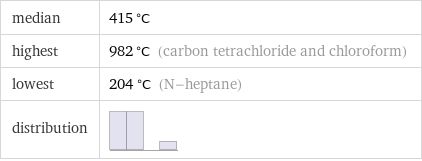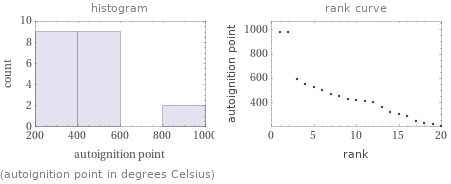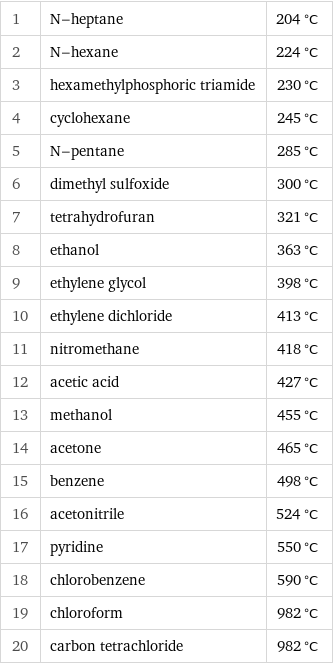Input interpretation

organic solvents | autoignition point
Summary

median | 415 °C highest | 982 °C (carbon tetrachloride and chloroform) lowest | 204 °C (N-heptane) distribution |
Distribution plots

(autoignition point in degrees Celsius)
Autoignition point rankings

1 | N-heptane | 204 °C 2 | N-hexane | 224 °C 3 | hexamethylphosphoric triamide | 230 °C 4 | cyclohexane | 245 °C 5 | N-pentane | 285 °C 6 | dimethyl sulfoxide | 300 °C 7 | tetrahydrofuran | 321 °C 8 | ethanol | 363 °C 9 | ethylene glycol | 398 °C 10 | ethylene dichloride | 413 °C 11 | nitromethane | 418 °C 12 | acetic acid | 427 °C 13 | methanol | 455 °C 14 | acetone | 465 °C 15 | benzene | 498 °C 16 | acetonitrile | 524 °C 17 | pyridine | 550 °C 18 | chlorobenzene | 590 °C 19 | chloroform | 982 °C 20 | carbon tetrachloride | 982 °C
Unit conversions for median autoignition point 415 °C

689 K (kelvins)

780 °F (degrees Fahrenheit)

1240 °R (degrees Rankine)

332 °Ré (degrees Réaumur)

226 °Rø (degrees Rømer)
Comparison for median autoignition point 415 °C

70 °C below typical temperature of an electric oven during self-cleaning (900 °F)

88 °C above melting point of lead (327.46 °C)
Corresponding quantities

Thermodynamic energy E from E = kT: | 59 meV (millielectronvolts)

Blackbody energy flux Φ from Φ = σT^4: | 12753 W/m^2 (watts per square meter)

Approximate luminous exitance from a planar blackbody radiator perpendicular to its surface: | 2.5×10^-4 lx (lux)